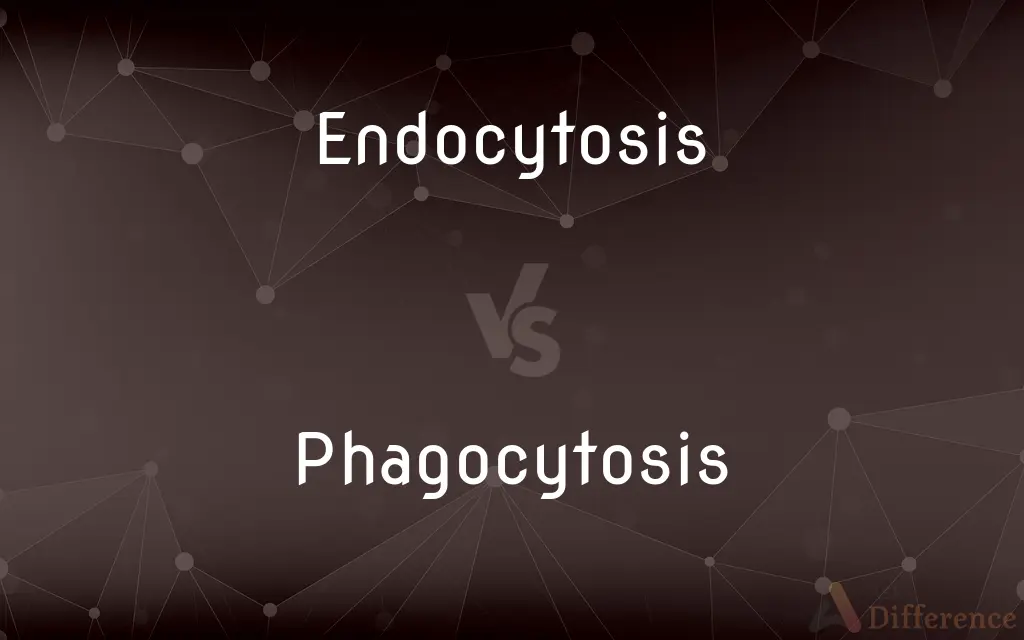Endocytosis vs. Phagocytosis — What's the Difference?
By Maham Liaqat & Fiza Rafique — Updated on April 16, 2024
Endocytosis is a cellular process that engulfs particles or liquids, involving various mechanisms, while phagocytosis is a specific type of endocytosis focused on engulfing large particles like bacteria.

Difference Between Endocytosis and Phagocytosis
Table of Contents
ADVERTISEMENT
Key Differences
Endocytosis is a broad term describing how cells internalize substances from their external environment, encompassing various forms such as pinocytosis and receptor-mediated endocytosis. On the other hand, phagocytosis specifically refers to the engulfment of large particles or cells, often used by immune cells to capture and destroy pathogens.
In endocytosis, the cell membrane invaginates, forming a pocket around the desired material, which can include fluids, dissolved substances, and small particles. Whereas, phagocytosis involves the cell membrane stretching out to enclose larger entities, such as bacteria or dead cells, forming what is known as a phagosome.
Endocytosis can be either constitutive, happening continuously in cells, or triggered by the binding of a molecule to a receptor on the cell surface. Conversely, phagocytosis is typically an active response to invading pathogens, triggered by the immune system, and involves distinct signaling pathways.
The vesicles formed during endocytosis are usually smaller and might contain a variety of substances including ions, nutrients, and signaling molecules. On the other hand, phagocytosis results in the formation of larger vesicles designed to contain and eventually degrade whole cells or large debris.
Both processes involve the rearrangement of the cytoskeleton, but phagocytosis particularly requires more extensive changes and often uses actin filaments to engulf and internalize the target, reflecting its role in immune defense and cellular cleanup.
ADVERTISEMENT
Comparison Chart
Definition
Cellular process of internalizing particles or fluids
Specific type of endocytosis for engulfing large particles
Subtypes
Includes pinocytosis, receptor-mediated endocytosis
N/A
Typical Substances
Liquids, dissolved substances, small particles
Large particles, such as bacteria and dead cells
Cellular Response
Can be constitutive or triggered
Usually an active immune response
Vesicle Size
Generally smaller
Larger, forms phagosomes
Compare with Definitions
Endocytosis
Can involve the uptake of fluids or solids.
Through endocytosis, cells can absorb nutrients dissolved in extracellular fluid.
Phagocytosis
A form of endocytosis involving large particles.
Macrophages perform phagocytosis to remove pathogenic bacteria.
Endocytosis
A cellular process for transporting substances into the cell.
Endocytosis helps neurons absorb the neurotransmitters necessary for signal transmission.
Phagocytosis
Involves the formation of large vesicles called phagosomes.
Once engulfed, the phagosome fuses with a lysosome to degrade its contents.
Endocytosis
Fundamental for cellular signaling and nutrient uptake.
Endocytosis is crucial for cells to respond to hormonal signals.
Phagocytosis
Critical for immune response and cellular debris clearance.
Phagocytosis is essential in defending against infections and cleaning up dead cells.
Endocytosis
Occurs through invagination of the cell membrane.
Receptor-mediated endocytosis is triggered when a molecule outside the cell binds to a receptor.
Phagocytosis
Requires significant rearrangement of the cytoskeleton.
Actin filaments mobilize to help macrophages engulf invading pathogens.
Endocytosis
May be non-specific or receptor-mediated.
Pinocytosis is a form of non-specific endocytosis where cells ingest extracellular fluid.
Phagocytosis
Typically triggered by the recognition of specific molecules on pathogens.
Phagocytic cells recognize foreign particles by their surface markers.
Endocytosis
Endocytosis is a cellular process in which substances are brought into the cell. The material to be internalized is surrounded by an area of cell membrane, which then buds off inside the cell to form a vesicle containing the ingested material.
Phagocytosis
Phagocytosis (from Ancient Greek φαγεῖν (phagein) 'to eat', and κύτος, (kytos) 'cell') is the process by which a cell uses its plasma membrane to engulf a large particle (≥ 0.5 μm), giving rise to an internal compartment called the phagosome. It is one type of endocytosis.
Endocytosis
A process of cellular ingestion by which the plasma membrane folds inward to bring substances into the cell.
Phagocytosis
The engulfing and destruction of particulate matter, such as a bacterium, by a cell.
Endocytosis
(cytology) The process by which the plasma membrane of a cell folds inwards to ingest material.
Phagocytosis
A form of endocytosis in which a cell incorporates a particle by extending pseudopodia and drawing the particle into a vacuole of its cytoplasm.
Phagocytosis
Process in which phagocytes engulf and digest microorganisms and cellular debris; an important defense against infection
Common Curiosities
Can all cells perform phagocytosis?
No, phagocytosis is primarily carried out by specialized immune cells such as macrophages and neutrophils.
What triggers a cell to perform phagocytosis?
Phagocytosis is typically triggered by the presence of pathogens or cellular debris that need to be cleared from the body.
How does receptor-mediated endocytosis work?
This process is triggered when external molecules bind to specific receptors on the cell surface, leading to vesicle formation.
What distinguishes endocytosis from phagocytosis?
Endocytosis is a general process for cellular intake, while phagocytosis specifically targets large particles for immune defense or debris clearance.
What role does the cytoskeleton play in phagocytosis?
The cytoskeleton, especially actin filaments, is reorganized to help the cell engulf and internalize large particles during phagocytosis.
How do cells choose between endocytosis and phagocytosis?
The choice depends on the size and nature of the material to be internalized; larger particles like pathogens initiate phagocytosis.
How do cells handle the substances they take in via endocytosis?
Cells can digest, recycle, or transport the substances to different areas within the cell depending on their nature and the cell's needs.
Why is phagocytosis important in healthcare?
Understanding phagocytosis can help in developing therapies to enhance immune responses against infections and diseases.
Is receptor-mediated endocytosis a form of phagocytosis?
No, receptor-mediated endocytosis is a subtype of endocytosis for specific molecules and typically involves smaller vesicles than those in phagocytosis.
What substances can be internalized via pinocytosis?
Pinocytosis typically involves the uptake of extracellular fluid and its dissolved small molecules.
How do endocytosis and phagocytosis contribute to cellular homeostasis?
They help maintain cellular environment by controlling the intake and processing of external substances.
Can phagocytosis be artificially induced?
Yes, certain treatments and drugs can enhance phagocytic activity to boost immune responses.
How are the vesicles in endocytosis and phagocytosis different?
Endocytosis often results in smaller vesicles, while phagocytosis forms larger phagosomes to contain and degrade larger targets.
What is the significance of vesicle size in cellular intake processes?
The size of vesicles determines the amount and type of material that can be internalized and processed by the cell.
What are some disorders associated with defective phagocytosis?
Defects in phagocytosis can lead to chronic infections and diseases like chronic granulomatous disease.
Share Your Discovery

Previous Comparison
Grammarly vs. Turnitin
Next Comparison
Kemono vs. FurryAuthor Spotlight
Written by
Maham LiaqatCo-written by
Fiza RafiqueFiza Rafique is a skilled content writer at AskDifference.com, where she meticulously refines and enhances written pieces. Drawing from her vast editorial expertise, Fiza ensures clarity, accuracy, and precision in every article. Passionate about language, she continually seeks to elevate the quality of content for readers worldwide.















































